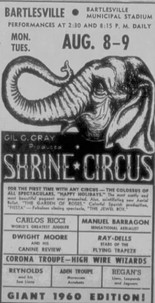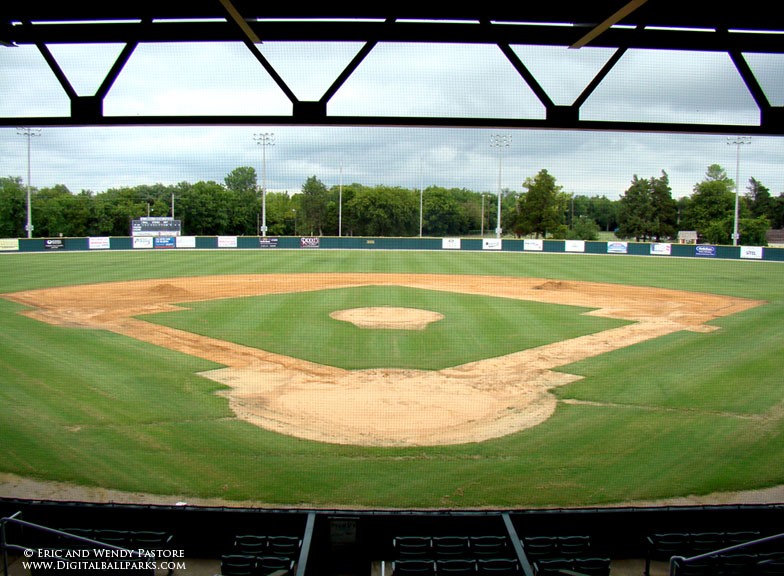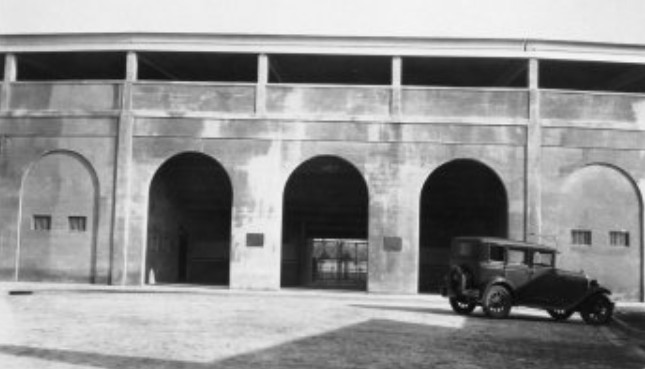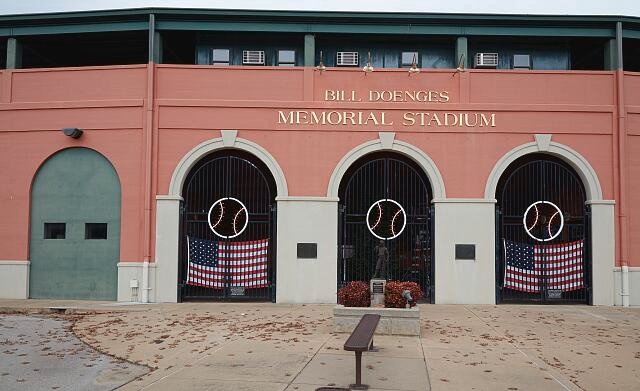Bill Doenges Memorial Stadium
Introduction
Text-to-speech Audio
This stadium has been the home of the national pastime in Bartlesville for over ninety years. When it was dedicated in the spring of 1932 as Bartlesville Municipal Stadium, it was considered a state-of-the-art facility and could accommodate 2,000 spectators. In its early decades, the stadium hosted numerous minor league baseball teams and traveling professional teams that included sports legends like Satchel Paige and Mickey Mantle. The stadium also served as the center for community entertainment, welcoming traveling shows and other sporting events during much of the twentieth century. Numerous updates throughout its history have helped maintain the stadium while slightly expanding its capacity, and in 1997, the venue was renamed in honor of Bill Doenges, a local automobile dealer who offered financial support to area athletics.
Images
Numerous events, like the Shrine Circus, would advertise their upcoming shows at Bartlesville Municipal Stadium in the town's newspaper.

Outdoor lighting and expanded seating was added to Bill Doenges Memorial Stadium in 1997.

Bartlesville Municipal Stadium was dedicated in 1932. Its grandstands and outfield fences are made with concrete.

Bartlesville Municipal Stadium was renamed Bill Doenges Memorial Stadium in 1997, in honor of the Bartlesville business man and philanthropist.

Backstory and Context
Text-to-speech Audio
Bartlesville Municipal Stadium was dedicated May 2, 1932, signifying the start of a new sporting era in Bartlesville. Prior to the stadium’s construction, the town featured a baseball park just north of the city limits on Dewey Avenue, built on land donated by William Johnstone in 1906 for the playing field. A wooden grandstand and fences were built around the field in 1909, and it was used as Bartlesville’s official ball field until 1931. The new Municipal Stadium featured a concrete grandstand that sat 2,000 spectators and cost $30,000. For years it was said that the stadium was the only professional baseball field in the country with the same distance to any part of the outfield fence, measuring 340 feet from home base to any fair section of the 14-foot-high concrete fence.
The stadium has been called home by numerous professional teams throughout its history. One of these was the Bartlesville Blues, a Negro League baseball team composed of all-Black players from the Bartlesville area. During the time of Jim Crow, almost every part of American life was segregated, including baseball. Before Jackie Robinson broke Major League Baseball’s color barrier in 1947, African American players participated in all-Black leagues around the country, known collectively as the Negro Leagues. The Blues played other all-African American teams from around Oklahoma, including the Guthrie Black Spiders and Tulsa Black Oilers. Advertised as “The Strongest Team in the Southwest”, they also welcomed regional all-star teams like the K.C. Royal Americans and Bay City, Texas All Stars. Even Satchel Paige, the legendary Negro League pitcher, stepped on the mound at Bartlesville Municipal Stadium, playing with the Blues in an exhibition game in 1945.
The Blues were not the only professional team to play in Bartlesville. For seven years, from 1946 to 1952, several teams from the Kansas-Oklahoma-Missouri League played at Bartlesville Municipal Stadium. The class D league served as a lower-level development organization for Major League teams like the Pittsburgh Pirates. Bartlesville’s team was called the Oilers in its first two seasons and the Pirates in its last five and would see 28 future major leaguers pass through its ranks. Like the Blues, the Oilers and Pirates played other minor league teams from the region, including the Ponca City Dodgers and Miami Owls from Oklahoma and the Chanute Giants and Independence Yankees from Kansas. The presence of the Blues, Oilers, and Pirates reflects baseball’s rise following World War II. As soldiers returned home and the economy boomed, White and Black Americans looked for entertainment and places to spend their newfound capital, and America’s pastime filled that role.
Baseball was not the only attraction offered at Bartlesville’s community field. Throughout the mid-twentieth century, the stadium played host to College High’s football team before a dedicated high school stadium was built in 1950. Traveling circuses, wrestling shows, and rodeos, also stopped through, as did an acrobat display advertised as “Flying Birdmen from Mexico”. In 1944, a fireworks display called the “Bombing of Tokyo” was held at Bartlesville Municipal Stadium, reflecting an intersection of family entertainment and current events during World War II.
The stadium was renamed Bill Doenges Memorial Stadium in 1997, in honor of the Bartlesville Ford dealer and community leader who championed local athletics. The renaming was accompanied by a renovation, which resulted in the installation of a lighting system and an expansion of capacity to 2,500 seats. In 1998, the Stadium Operating Committee was created by a city ordinance, and since the advisory board’s creation, Bartlesville has played host to the American Legion World Series twice, in 2003 and during Oklahoma’s centennial celebration in 2007.
Sources
"Baseball Historian, Author Phil Dixon to Speak Sunday." Examiner-Enterprise (Bartlesville) April 17th 2018.
Bill Doenges Memorial Park Stadium, Bartlesville Sports Commission. Accessed May 1st 2022. https://bartlesvillesports.com/facilities/bill-doenges-memorial-park-stadium-bartlesville-sports-commission/.
"Bill Pierro To Hurl Tonight's Game Against Chanute Team." Examiner-Enterprise (Bartlesville) August 6th 1948. 4.
Examiner Enterprise (Bartlesville) August 7th 1960. 16.
Examiner-Enterprise (Bartlesville) August 16th 1957. 14.
Examiner-Enterprise (Bartlesville) May 31st 1943. 6.
Examiner-Enterprise (Bartlesville) October 20th 1944. 5.
"Twenty Five Years Ago." Tri-County Weekly News Review (Bartlesville) September 12th 1963. 17.
Wilt, Mike. Bartlesville's Own West Side Story. b Monthly. February 1st 2019. 22 - 27.
Bartlesville Examiner-Enterprise
Bartlesville Area History Museum
Bartlesville Area History Museum
Carol Highsmith, Library of Congress
